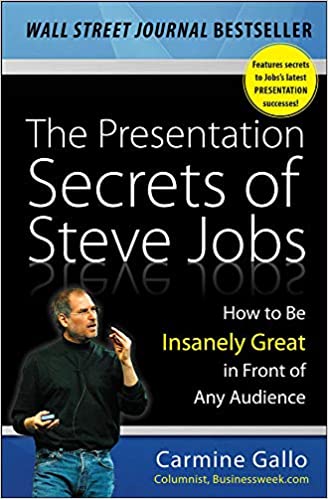The Presentation Secrets of Steve Jobs
By: Carmine Gallo

Carmine Gallo opens his book with a stark reminder: Juries compare courtroom presentations (consciously or not) to those of Steve Jobs and others like him who have “transformed the typical, dull technical plodding slide show into a theatrical event complete with heroes, villains, a supporting cast, and stunning backdrops.” In fact, it’s easy to forget that the subject of Jobs’ presentations—new technology—would typically have made for a dull presentation in the hands of most presenters. Jobs made the subject compelling and entertaining.
Gallo analyzes three key components that lead to great presentations: (1) create the story; (2) deliver the experience; and (3) refine and rehearse. Gallo explains each component with vivid examples from Jobs’ presentations.
To create the story, Gallo identifies nine essential elements from Jobs’ presentations. To begin, Jobs’ presentations open with a “headline”, a short (less than 140-characters) statement that introduces one big idea. Just like a newspaper headline, this statement is meant to capture the audience’s attention. The headline summarizes the substance of the presentation without unnecessary detail. For example, in his presentation revealing the iPhone, the headline was, “Today, Apple reinvents the phone.” In only five words, Jobs was able to convey his key message and leave the audience anxious to hear more.
Another key element of Jobs’ presentations is the “Roadmap”. Gallo devotes an entire chapter to this critical skill, and he shows how Jobs always introduced his presentation with an agenda, succinctly stating the three to four key topics he would cover in the presentation to orient his audience. Gallo explains the importance of keeping the agenda short based on studies that show most individuals will not remember more than a few discrete topics. Gallo provides further examples of other great orators (including John F. Kennedy and Barrack Obama) to show the power of a three-part roadmap.
Jobs also builds stories into his presentations through the use of character archetypes. Gallo explains that, rather than discussing products in terms of facts and features, Jobs first introduces an antagonist: the looming problem that must be addressed. Jobs would artfully turn a technological gap or consumer complaint into a shared problem his audience wanted solved. That way, products are not introduced based on features; instead, they are introduced as “conquering heroes” to solve the problems Jobs set up.
Beyond creating a story, Jobs masterfully delivered his presentations. Gallo highlights that one critical aspect of Jobs’ presentations is how he would “dress up numbers,” simplifying complicated information and creating a direct connection to the audience. For instance, Jobs did not describe the iPod in terms of gigabytes or other technical jargon. Instead, he said, “1,000 songs in your pocket.” Likewise, when Jobs introduced the “world’s thinnest laptop,” he did not describe its dimensions, but he told his audience it is “so thin it even fits inside one of those envelopes you see floating around the office”. In each case, Jobs took what could be abstract numbers and made them meaningful to his audience. As Gallo explains, numbers must be “specific, relevant, and contextual.”
Jobs’ presentations were also aided by slideshows, but Gallo shows how the slides were merely a backdrop to enhance the core of the presentation: Jobs himself. Gallo provides numerous examples of Jobs’ slides, but the key takeaway is simplicity. Frequently, Jobs used a single word or image to complement his oral presentation. Critically, too, Jobs used whatever words were written on his slide verbatim, using that to reinforce his point. To describe Jobs’ slides, Gallo quotes painter Hans Hoffman, who said, “The ability to simplify means to eliminate the unnecessary so that the necessary may speak.”
Perhaps most importantly, Gallo explains how Jobs achieves his hallmark demeanor, which blends comfort, confidence, and an appearance of effortlessness—sprezzatura. Gallo takes readers behind the scenes of Jobs’ presentations to show the immense effort necessary to present like Jobs. Jobs dedicated hundreds of hours to prepare for a presentation, rehearsing each component and giving attention to minute details to ensure the presentation would be flawless. And paradoxically, it was this meticulous, thorough practice that ultimately allowed Jobs to appear effortless and spontaneous.